OIST has a 7-day summer leave that we can/must take in August or September. That's also the peak tourist season on Okinawa, so we decided to escape the crowded beaches for the streets and high-rises of illustrious Singapore.
 |
Singapore. |
This was the first time in Singapore for me, and I didn't really know what to expect. Everybody keeps saying that the food is great but the city itself isn't too exciting. We mostly travel for the food anyway, so we figured it was worth a shot.
 |
Cafe. |
We had to go there on a roundabout route: Naha to Osaka, then another 7 hour flight from Osaka to Singapore. It's _really_ roundabout; we passed right over Okinawa and Naha again two hours into the second flight. Fortunately Jetstar (an LCC) have now started direct flights between Naha and Singapore, so it'll be much easier next time we go.
 |
"I can see my house from here!" Not quite; this is Taketomi island in the western part of Okinawa. We did pass right over Naha, but I didn't get a picture. |
Singapore is about half the size of Okinawa island; that's small of course, but still a lot bigger than I thought. I'd somehow assumed that Singapore was just a city state, but there's clearly (a bit) more to it than that. It is completely dominated by the city, though, and we didn't see any other part of the country.
 |
A well-groomed park near Newton. This is about as close as we got to actual nature during this trip. Not that we ever go looking for it of course; we travel to cities for a reason. |
 |
There's not a lot of nature, but there is a lot of greenery. Singapore is right on the equator after all, and the city is very lush and green. Very pleasant. |
Singapore has a lot of manufacturing industries, one of the largest seaports in the world, and is one of the major financial centers. Over 25% of the population are immigrants, ranging from Malaysians cleaning hotel rooms to expat European bankers. It is also the richest city on the planet. This means a lot of in-your-face conspicuous consumption. It gets a little silly at times.
Corporate towers and high-end apartment complexes have (very visible) flourishes such as roof-top gardens, light shows and terraces. Expensive cars are _everywhere._ Some people desperate for attention resort to painting their million-dollar Ferraris and Lamborghinis in loud colours and patterns just to stand out from the crowd.
 |
We stayed at Goodwood Park Hotel. A nice resort-style place right in the city center. |
 |
Your humble correspondent in front of some shopping mall or other. Which one doesn't matter; they're all lined up cheek to jowl, and all with the same worldwide brands. |
Cars, by the way, cost 3-5 times more than in Japan, and you need to bid for one of a limited total number of permits. Singapore also has excellent public transport, with a dense network of subways, buses and local trains. And if you live in the city itself, you are apparently only allowed to drive every other day, so you can't even rely on your car for your daily transportation. Unless you're driving in from outside the city, a personal car is really a pure status symbol.
Salary levels are high, but so are living costs. I may be wrong, but I get the impression that "keeping up" with other people by having the right car, home, schools and so on is very important here.
 |
The subway is clean, neat and efficient. |
 |
A nap in the midday heat. |
 |
Coffee break. |
We largely spent our time around the city center, walking or taking the subway to the different areas. There's an enormous variety of very good food for any budget level here. Singapore is mostly ethnically Chinese but there are sizeable Indian, Arab and Malay minorities, and they each leave strong impressions on the culture and foods in the city.
 |
Noodles and pork. |
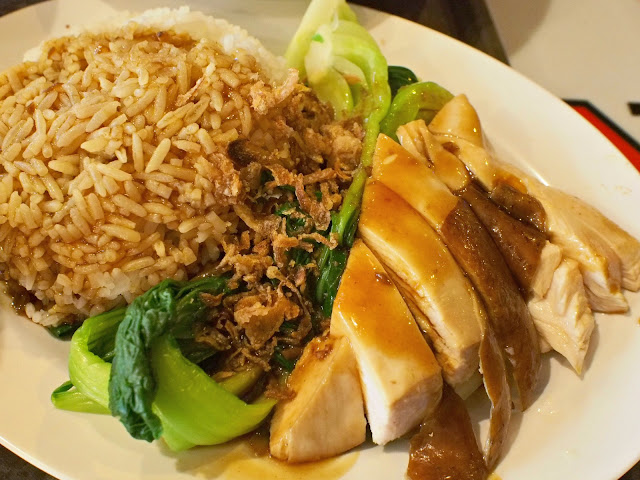 |
Chicken rice. The point here is the flavoured rice; some people apparently like to order chicken rice without the chicken. |
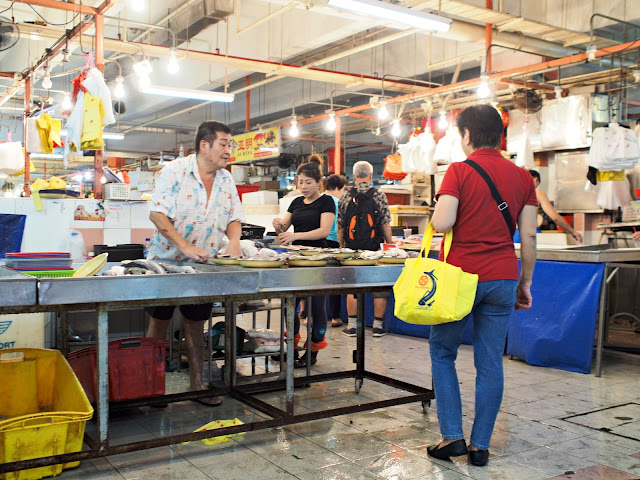 |
Fish market in Chinatown. |
 |
Dinner time. Laksa, stir-fried vegetable, fried rice and fried spring rolls. Like Singapore itself it's mostly Chinese with a strong influence of Malay cuisine. |
We spent a few days around Little India and Arab Street, where we had Indian and Arab food. Unsurprisingly, the most fun is the cheaper eateries where the focus is on the food itself rather than class and ambiance.
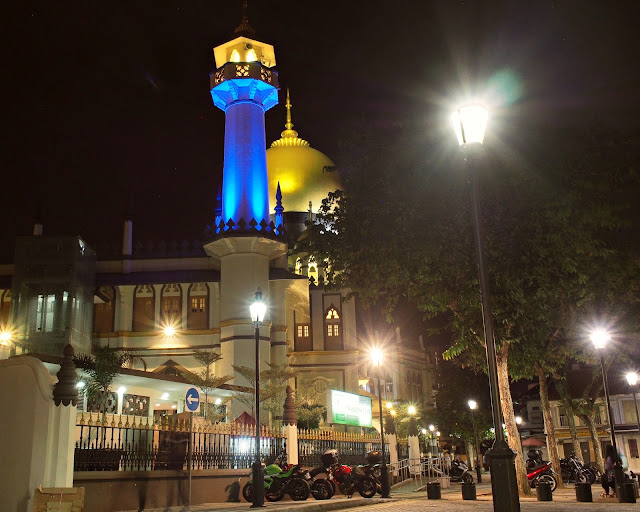 |
The Sultan mosque in the Arab section. |
 |
Good food this way. Or any way; while it varied a lot, we didn't have a single truly bad meal during this trip. |
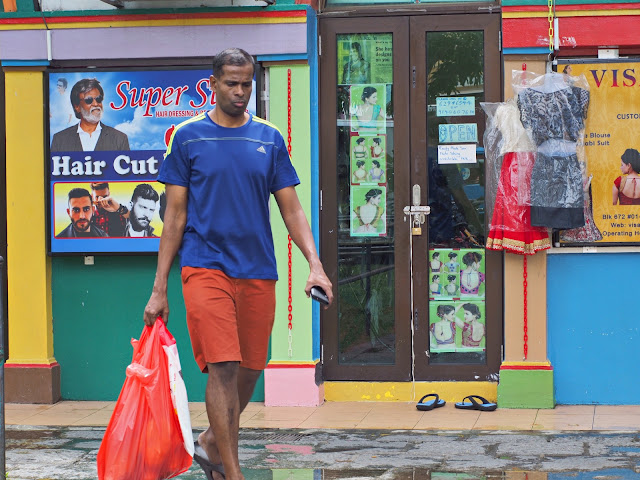 |
Super Star Hair Cut. Little India. |
Wherever we go, we try to find the time for a cooking class. It's a fun way to spend a morning, and a good way to learn a little more about the local food traditions. More often than not we also come away with a recipe or two we put into rotation at home.
 |
The Food Playground cooking school. A small group of students, an engaging and knowledgeable teacher, and we got to do most of the prep work and cooking ourselves. It had a very similar kind of vibe to Hanoi Cooking Centre (in Hanoi, obviously), our favourite cooking class so far. I can warmly recommend this place. |
 |
Our chicken curry with roti jala. We've made this a couple of times since, and it turns out great. |
My biggest disappointment was electronics. I'd hoped that, as one of the major electronics manufacturing and trading centers, I'd be able to find fun offbeat stuff and cheap devices. But overall, things such as laptops, computer parts and circuit boards were actually more expensive in Singapore than in Osaka or Tokyo; and the parts stores had nothing I couldn't just as easily find at home.
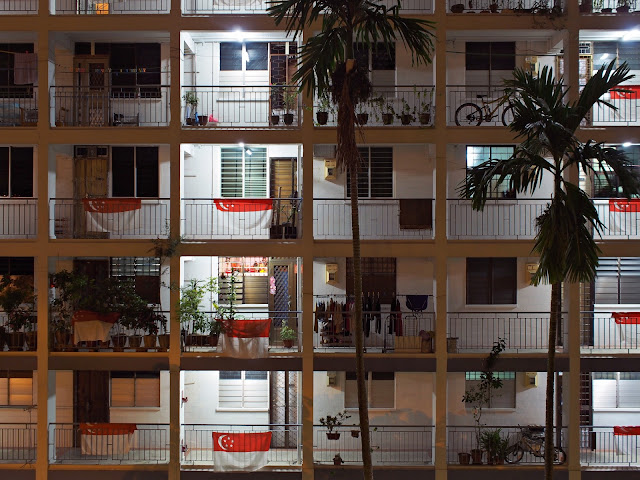 |
Apartments. Hanging the Singaporean flag is something you do, apparently. |
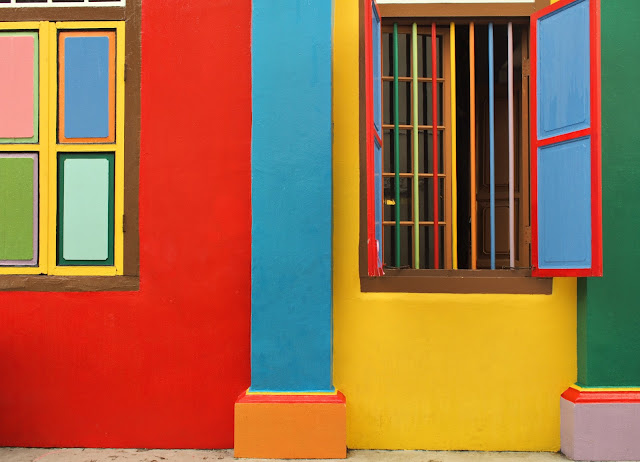 |
Little India. |
 |
| Coffee break. |
 |
Nighttime on Arab street. |
The city itself is beautiful and colourful, but, well, bland. It's organized and regulated to within an inch of its life. This is really the first Asian city to make Japanese society feel excitingly spontaneous and unpredictable by comparison. It's the kind of place where warning signs have warning signs. I won't say it's downright boring, but I don't feel very compelled to take pictures when even the street views seem carefully preplanned and designed.
 |
Apartments. |
 |
Mural in Little India. |
 |
A bridge fundament. I like the shapes. |
Is it worth going? If you like food, then yes, absolutely. The reputation as a food center is well deserved. If you expect an exotic experience or an Asian atmosphere you may be disappointed. And if you like shopping you'll just find the same brands, at the same prices, as absolutely everywhere in the world. But we like food, and for that we will certainly return.
 |
Umbrellas. |



No comments:
Post a Comment
Comment away. Be nice. I no longer allow anonymous posts to reduce the spam.